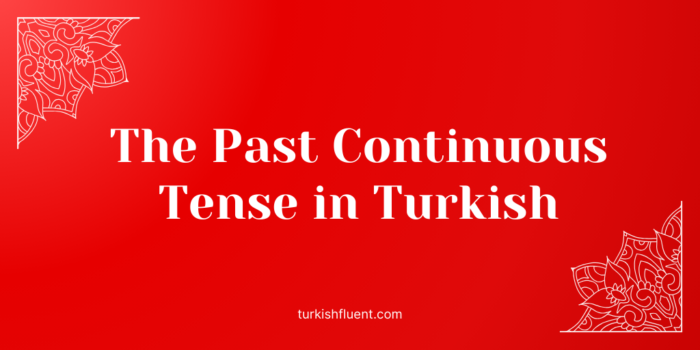The past continuous tense in Turkish (or Imperfect Tense), known as Şimdiki Zamanın Hikayesi, is used to describe actions that were happening continuously or repeatedly in the past. It corresponds to the English past continuous tense (“I was doing…”).
This tense is commonly used to describe:
- Actions that were happening at a specific time in the past.
- Repetitive or habitual past actions.
- Actions that were interrupted by another event.
- Past abilities or limitations.
Below, we will explore its structure, usage, and examples to help you understand how to use it effectively. Hadi okuyalım!
Table of Contents
Conjugation of the Past Continuous Tense in Turkish
The past continuous tense is formed by adding the suffix -iyordu to the verb root, adjusted for vowel harmony. Here is the conjugation of the verb gitmek (to go):
| Subject | Positive | Negative | Positive Question | Negative Question |
|---|---|---|---|---|
| Ben (I) | gidiyordum | gitmiyordum | gidiyor muydum? | gitmiyor muydum? |
| Sen (You) | gidiyordun | gitmiyordun | gidiyor muydun? | gitmiyor muydun? |
| O (He/She/It) | gidiyordu | gitmiyordu | gidiyor muydu? | gitmiyor muydu? |
| Biz (We) | gidiyorduk | gitmiyorduk | gidiyor muyduk? | gitmiyor muyduk? |
| Siz (You, plural/formal) | gidiyordunuz | gitmiyordunuz | gidiyor muydunuz? | gitmiyor muydunuz? |
| Onlar (They) | gidiyorlardı | gitmiyorlardı | gidiyorlar mıydı? | gitmiyorlar mıydı? |
Usage and Examples
1. Actions Happening Continuously or Repeatedly in the Past
This usage describes actions that occurred frequently or habitually in the past.
Examples:
- Kız arkadaşım ve ben her yıl Türkiye’yi ziyaret ediyorduk. (My girlfriend and I used to visit Turkey every year.)
- Çocukken her hafta sonu piyano kursuna gidiyordum. (When I was a child, I used to go to piano lessons every weekend.)
- Annem her Türk dizisi izlediğinde ağlıyordu. (My mom used to cry every time she watched a Turkish TV series.)
2. Describing a Specific Moment in the Past
This structure is used for describing what someone was doing at a particular moment in the past. Imagine you’re a detective trying to solve a mystery. You’ve got suspects, witnesses, and one big question:
Examples:
- Dün gece olay saatinde ne yapıyordun? (What were you doing at the time of the incident last night?)
- Deprem olduğunda uyuyorduk. (We were sleeping when the earthquake happened.)
- Yağmur başladığında sahilde yürüyüş yapıyordum. (I was taking a walk on the beach when it started to rain.)
- Eve girdiğimde Ahmet son ses müzik dinliyordu. (When I entered the house, Ahmet was listening to music at full volume.)
3. Incomplete Actions
When Şimdiki Zamanın hikayesi is used with tam, az kalsın, neredeyse, the meaning shifts to an action that was almost completed or interrupted.
- Tam… -ken = When I was about to…
- Az kalsın / Neredeyse = Almost, nearly
Examples:
- Dün merdivenlerden inerken neredeyse / az kalsın düşüyordum. (I almost fell while going down the stairs yesterday.)
- Araba kullanırken neredeyse / az kalsın kediye çarpıyordum. (While driving, I almost hit a cat.)
- Hastanede kan verirken az kalsın / neredeyse bayılıyordu. (While giving blood at the hospital, he/she almost fainted.)
4. Expressing Past Abilities with -ebil/-abil
When you use Şimdiki Zamanın Hikayesi with ebil/abil, you can talk about things you used to be able to do in the past but can’t anymore or the other way around.
Examples:
- Eskiden sayfalarca yazı yazabiliyordum ama şimdi elim ağrıyor. (I used to be able to write pages and pages, but now my hand hurts.)
- Türkiye’ye ilk geldiğimde hiç Türkçe konuşamıyordum ama şimdi herkesle sohbet edebiliyorum. (When I first came to Turkey, I couldn’t speak Turkish at all, but now I can chat with everyone.)
- Gençken sabahlara kadar partileyebiliyordum ama şimdi hemen uykum geliyor. (When I was young, I could party until the morning, but now I get sleepy right away.)
Conclusion
The past continuous tense in Turkish (Şimdiki Zamanın Hikayesi) is used to describe ongoing or repeated actions in the past, specific moments, incomplete actions, and past abilities. It follows a straightforward conjugation pattern and is often used in everyday conversation.
Now that you learned the past continuous, it’s time to understand how to form sequential actions in Turkish with -ıp, -ip, -up, -üp.
